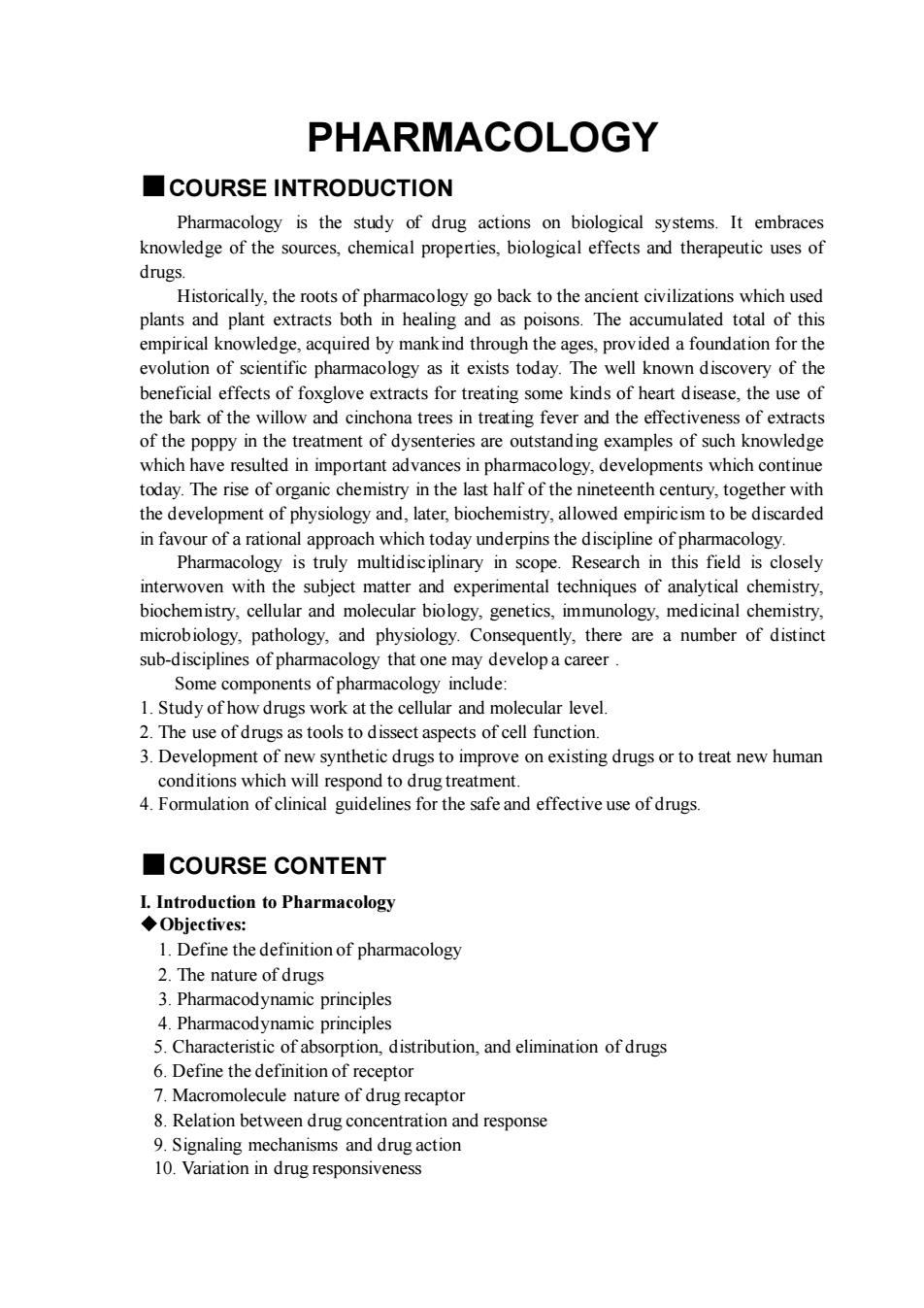
PHARMACOLOGY ■COURSE INTRODUCTION Pharmacology is the study of drug actions on biological systems.It embraces knowledge of the sources,chemical properties,biological effects and therapeutic uses of drugs. Historically,the roots of pharmacology go back to the ancient civilizations which used plants and plant extracts both in healing and as poisons.The accumulated total of this empircal by mankind throuh the ages,for the evolution of scientific pharmacology as it exists today.The well known discovery of the beneficial effects of foxglove extracts for treating some kinds of heart disease,the use of the bark of the willow and cinchona trees in treating fever and the effectiveness of extracts of the poppy in th reatmnt of dysenteries re outstanding examps of such which have resulted in important advances in pharmacology,developments which continue today.The rise of organic chemistry in the last half of the nineteenth century,together with the development of physiology and,later,biochemistry,allowed empiricism to be discarded in favour of a rational approach which today underpins the discipline of pharmacology. Pharmacology is truly multidisciplinary in scope.Research in this field is closely interwoven with the subject matter and experimental techniques of analytical chemistry. iochen and molecular biology,genetic immunology,medicinal chemistry microbiology,pathology,and physiology.Consequently,there are a number of distinct sub-disciplines of pharmacology that one may develop a career. Some components of pharmacology include: .Study of how drugs work at the cellular and molecular level 2.The use of drugs as tools to dissect aspects of cell function. 3.Development of new synthetic drugs to improve on existing drugs or to treat new human condtions which willrespnd to du treatment on of clinical guidelines for the safe and effective use of drugs ■COURSE CONTENT I.Introduction to Pharmacology ◆Objectives:. 1.Define the definition of pharmacology 2.The nature of drugs 3.Pharmacodynamic principles 4.Pharmacodynamic principles 5.Characteristic of absorption,distribution,and elimination of drugs 6.Define the definition of receptor 7.Macromolecule nature of drug recaptor 8.Relation between drug concentration and response 9.Signaling mechanisms and drug action 10.Variation in drug responsiveness
PHARMACOLOGY ■COURSE INTRODUCTION Pharmacology is the study of drug actions on biological systems. It embraces knowledge of the sources, chemical properties, biological effects and therapeutic uses of drugs. Historically, the roots of pharmacology go back to the ancient civilizations which used plants and plant extracts both in healing and as poisons. The accumulated total of this empirical knowledge, acquired by mankind through the ages, provided a foundation for the evolution of scientific pharmacology as it exists today. The well known discovery of the beneficial effects of foxglove extracts for treating some kinds of heart disease, the use of the bark of the willow and cinchona trees in treating fever and the effectiveness of extracts of the poppy in the treatment of dysenteries are outstanding examples of such knowledge which have resulted in important advances in pharmacology, developments which continue today. The rise of organic chemistry in the last half of the nineteenth century, together with the development of physiology and, later, biochemistry, allowed empiricism to be discarded in favour of a rational approach which today underpins the discipline of pharmacology. Pharmacology is truly multidisciplinary in scope. Research in this field is closely interwoven with the subject matter and experimental techniques of analytical chemistry, biochemistry, cellular and molecular biology, genetics, immunology, medicinal chemistry, microbiology, pathology, and physiology. Consequently, there are a number of distinct sub-disciplines of pharmacology that one may develop a career . Some components of pharmacology include: 1. Study of how drugs work at the cellular and molecular level. 2. The use of drugs as tools to dissect aspects of cell function. 3. Development of new synthetic drugs to improve on existing drugs or to treat new human conditions which will respond to drug treatment. 4. Formulation of clinical guidelines for the safe and effective use of drugs. ■COURSE CONTENT I. Introduction to Pharmacology ◆Objectives: 1. Define the definition of pharmacology 2. The nature of drugs 3. Pharmacodynamic principles 4. Pharmacodynamic principles 5. Characteristic of absorption, distribution, and elimination of drugs 6. Define the definition of receptor 7. Macromolecule nature of drug recaptor 8. Relation between drug concentration and response 9. Signaling mechanisms and drug action 10. Variation in drug responsiveness
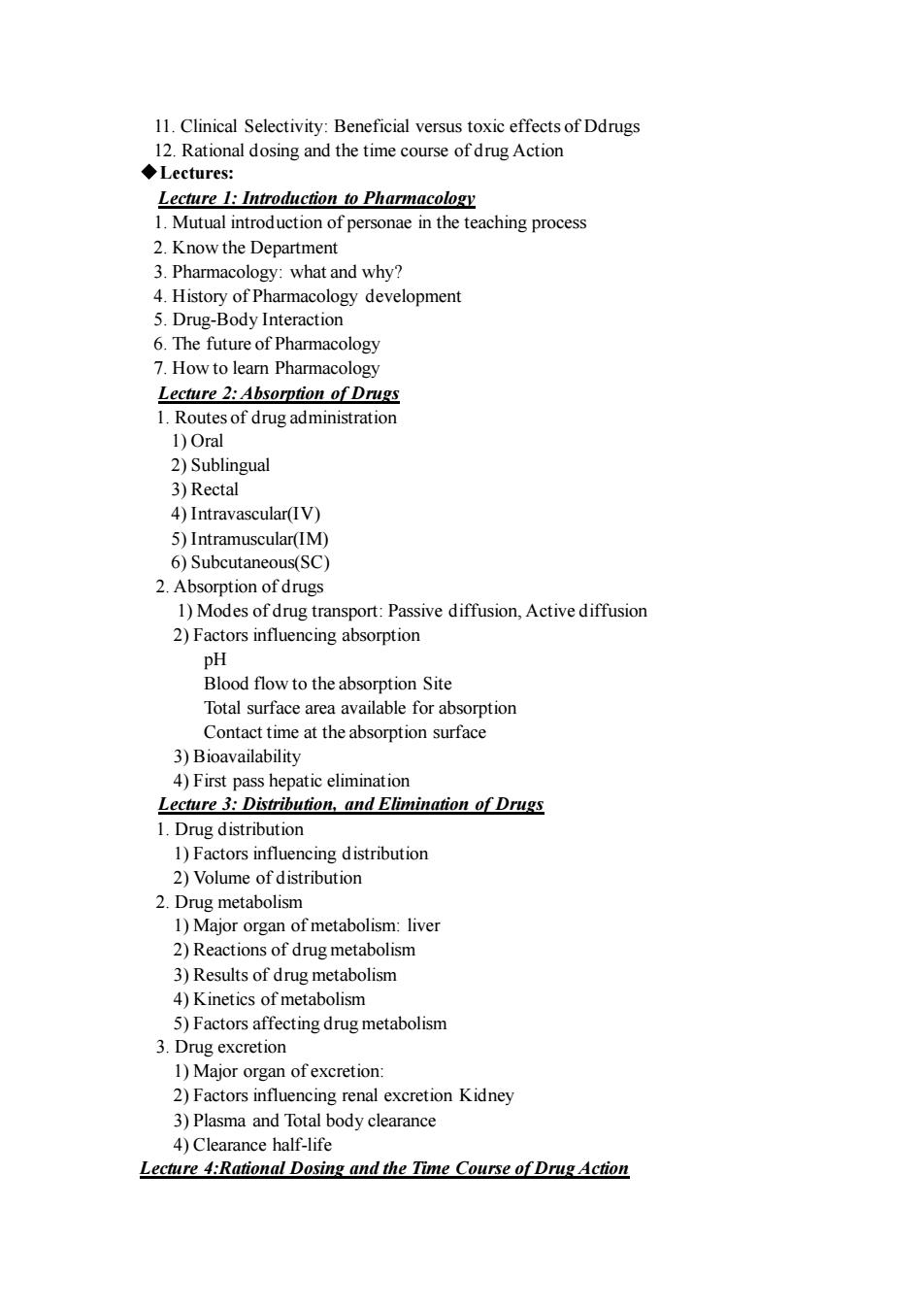
11.Clinical Selectivity:Beneficial versus toxic effects of Ddrugs 12.Rational dosing and the time course ofdrug Action Lectures Lecture 1:Introduction to Pharmacology 1.Mutual introduction of personae in the teaching process 2.Know the Department what and why? 4.History of P rmacology development 5.Drug-Body Int ractio 6.The future of Pharmacology 7.How to learn Pharmacolog utes of drug ac ministratio 2)Sublingual 3)Rectal 4)Intravascular(V) 5)Intram IM )Subcutaneous(SC 2.Absorption of drugs 1)Modes of drug transport:Passive diffusion,Active diffusion 2)Factors influencing absorption tion Sit lotal surface area available for absorption Contact time at the absorption surface 3)Bioavailability 4)First pass hepatic elimination 1.Drug distribution 1)Factors influencing distribution 2)Volume of distribution 2.Drug metabolism 1)Major organ of metabolism:liver 2)Reacti of drug metabolism 3)Results of drug metabolism 4)Kinetics of metabolism 5)Factors affecting drug metabolism 3.Drug excretion 1)Mai of excretion encing renal excretion Kidney 3)Plasma and Total body clearance 4)Clearance half-life Lecture 4:Rational Dosing and the Time Course of Drug Action
11. Clinical Selectivity: Beneficial versus toxic effects of Ddrugs 12. Rational dosing and the time course of drug Action ◆Lectures: Lecture 1: Introduction to Pharmacology 1. Mutual introduction of personae in the teaching process 2. Know the Department 3. Pharmacology: what and why? 4. History of Pharmacology development 5. Drug-Body Interaction 6. The future of Pharmacology 7. How to learn Pharmacology Lecture 2: Absorption of Drugs 1. Routes of drug administration 1) Oral 2) Sublingual 3) Rectal 4) Intravascular(IV) 5) Intramuscular(IM) 6) Subcutaneous(SC) 2. Absorption of drugs 1) Modes of drug transport: Passive diffusion, Active diffusion 2) Factors influencing absorption pH Blood flow to the absorption Site Total surface area available for absorption Contact time at the absorption surface 3) Bioavailability 4) First pass hepatic elimination Lecture 3: Distribution, and Elimination of Drugs 1. Drug distribution 1) Factors influencing distribution 2) Volume of distribution 2. Drug metabolism 1) Major organ of metabolism: liver 2) Reactions of drug metabolism 3) Results of drug metabolism 4) Kinetics of metabolism 5) Factors affecting drug metabolism 3. Drug excretion 1) Major organ of excretion: 2) Factors influencing renal excretion Kidney 3) Plasma and Total body clearance 4) Clearance half-life Lecture 4:Rational Dosing and the Time Course of Drug Action
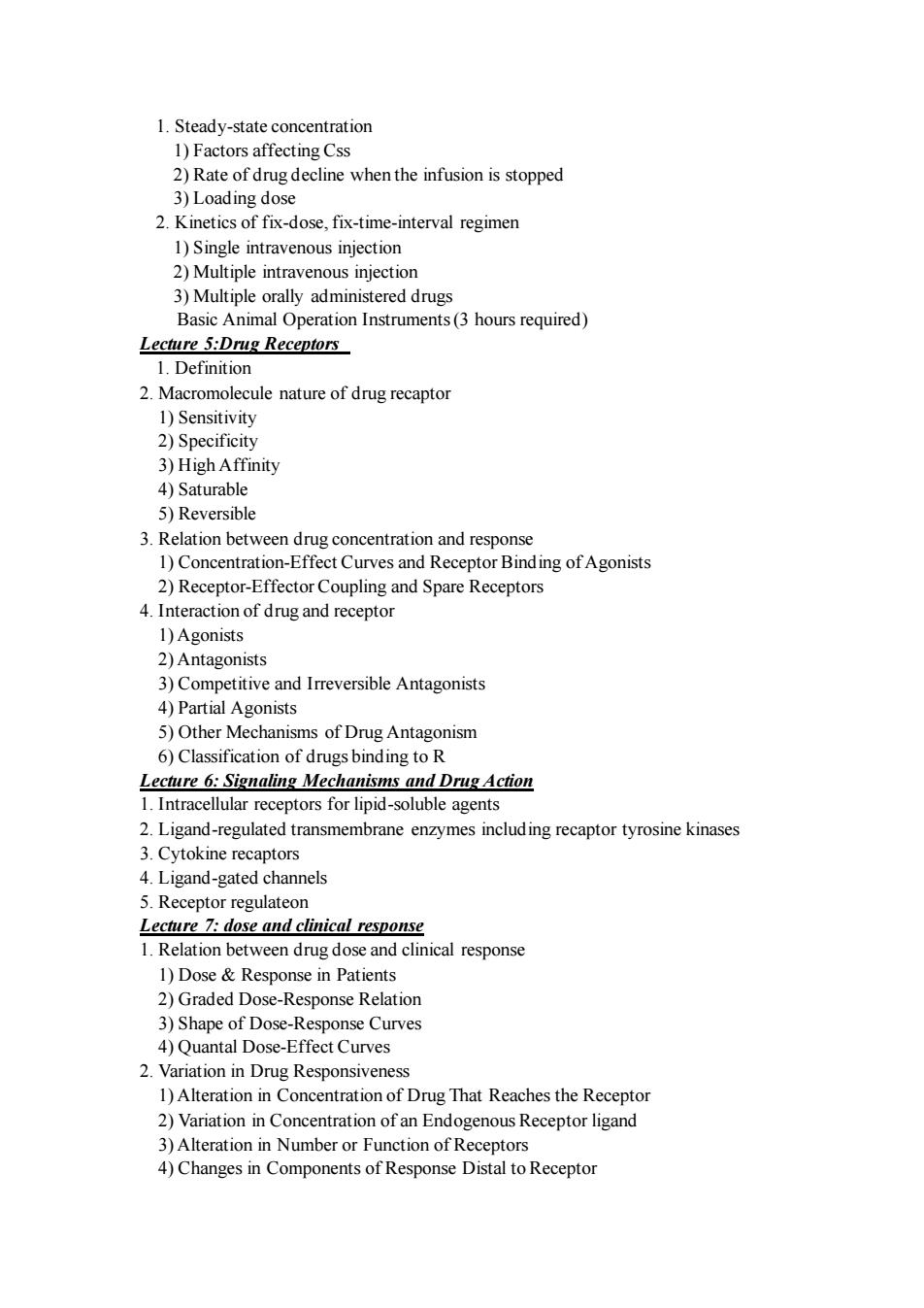
1.Steady-state concentration 1)Factors affecting Cs 2)Rate of drug decline when the infusion is stopped 3)Loading dose 2.Kinetics of fix-dose,fix-time-interval regimen 1)Single intravenous injection 2)Multiple intr venous injectic 3)Multiple orally administered drugs Basic Animal Operation Instruments(3 hours required) Lecture 5:Drug Receptors 1.Definition 2.Macromolecule nature of drug recaptor 1)Sensitivity 2)Specificity 3)High Affinitv 4)Saturable 5)Reversible 1)Concentration-Effect Curves and Receptor Binding ofAgonists 2)Receptor-Effector Coupling and Spare Receptors 4.Interaction of drug and receptor 1)Agonists 2)Antagonists 3)Competitive and Irreversible Antagonists 4)Partial Agonists 5)Other mechanisms of drug antagonism 6)Classification of drugs binding to R Lecture 6:Signaling Mechanisms and dr ug Action .Intracellular receptors for lipid soluble agents 2.Ligand-regulated transmembrane enzymes including recaptor tyrosine kinases 3.Cytokine recaptors 4.Ligand-gated channels 5.Receptor regulateon Lecture 7:dose and clinical respons 1.Relat ionbetween inca espons 1)Dose Response in Patients 2)Graded Dose-Response Relation 3)Shape of Dose-Response Curves 4)Qua ntal Dose-Effec rves 2.Va tion in Drug Responsivenes 1)Alteration in Concentration of Drug That Reaches the Receptor 2)Variation in Concentration of an Endogenous Receptor ligand 3)Alteration in Number or Function of Receptors 4)Changes in Components of Response Distal to Receptor
1. Steady-state concentration 1) Factors affecting Css 2) Rate of drug decline when the infusion is stopped 3) Loading dose 2. Kinetics of fix-dose, fix-time-interval regimen 1) Single intravenous injection 2) Multiple intravenous injection 3) Multiple orally administered drugs Basic Animal Operation Instruments (3 hours required) Lecture 5:Drug Receptors 1. Definition 2. Macromolecule nature of drug recaptor 1) Sensitivity 2) Specificity 3) High Affinity 4) Saturable 5) Reversible 3. Relation between drug concentration and response 1) Concentration-Effect Curves and Receptor Binding of Agonists 2) Receptor-Effector Coupling and Spare Receptors 4. Interaction of drug and receptor 1) Agonists 2) Antagonists 3) Competitive and Irreversible Antagonists 4) Partial Agonists 5) Other Mechanisms of Drug Antagonism 6) Classification of drugs binding to R Lecture 6: Signaling Mechanisms and Drug Action 1. Intracellular receptors for lipid-soluble agents 2. Ligand-regulated transmembrane enzymes including recaptor tyrosine kinases 3. Cytokine recaptors 4. Ligand-gated channels 5. Receptor regulateon Lecture 7: dose and clinical response 1. Relation between drug dose and clinical response 1) Dose & Response in Patients 2) Graded Dose-Response Relation 3) Shape of Dose-Response Curves 4) Quantal Dose-Effect Curves 2. Variation in Drug Responsiveness 1) Alteration in Concentration of Drug That Reaches the Receptor 2) Variation in Concentration of an Endogenous Receptor ligand 3) Alteration in Number or Function of Receptors 4) Changes in Components of Response Distal to Receptor
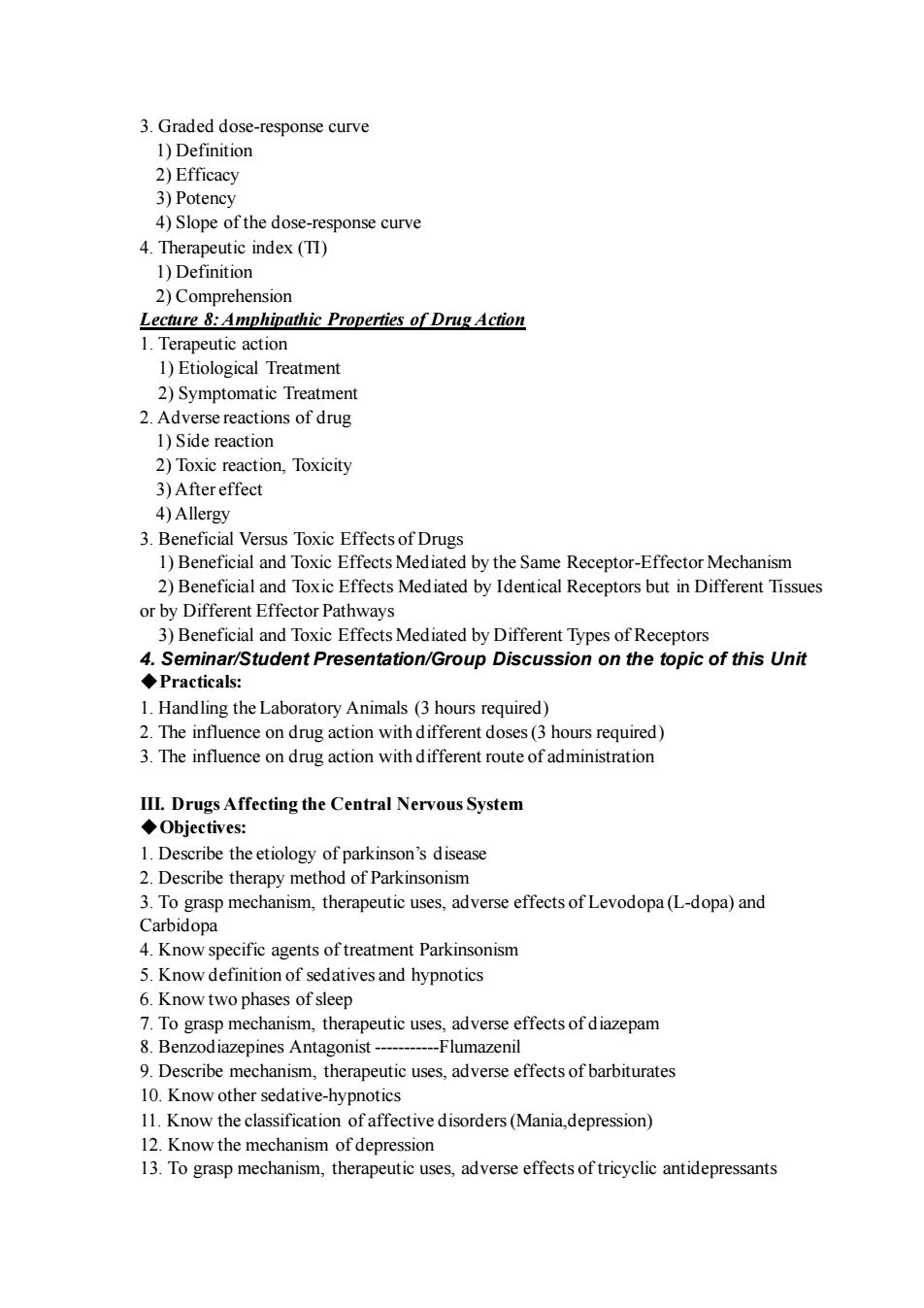
3.Graded dose-response curve 1 Definition 2)Efficacy 3)Potency 4)Slope of the dose-response curve 4.Therapeutic index (TI) 1)Definition 2)Comprehe Lecture 8:Amphipathic Properties of Drug Action I.lerapeutic action 1)Etiological Treatment 2)Symptomatic Treatment 2.Ad rse reactions of drug 1)Side reaction 2)Toxic reaction.Toxicity 3)After effect 4)Allergy Benefici sToxic Effects of Drugs 1)Beneficial and ic Effects Media by the Same Receptor-Effector Mechanism 2)Beneficial and Toxic Effects Mediated by Identical Receptors but in Different Tissues or by Different effector Pathways 3)Beneficial and Toxic Effects Mediated by Different Types of Receptors 4.Seminar/Student Presentation/Group Discussion on the topic of this Unit ◆Practicals: 1.Handling the Laboratory Animals (3 hours required) 2.The influence on drug action with different doses(3 hours required) 3.The influence on drug action with different route of administration III.Drugs Affecting the Central Nervous System 1.Describe the etiology of parkinson's disease 2.Describe therapy method of Parkinsonism 3.To grasp mechanism,therapeutic uses,adverse effects of Levodopa(L-dopa)and Carbidopa 4.Know specific agents oftreatme Parkinsonisn 5.Know definition of sedatives and hypnotics 6.Know two phases of sleep 7.To grasp mechanism,therapeutic uses,adverse effects of diazepam 8 Benzodiazepines Antagonist --Flumazenil 9.Describe erap utic uses,adverse effects of barbiturates 10.Know other sedative-hypnotics 11.Know the classification of affective disorders(Mania,depression) 12.Know the mechanism of depression 13.To grasp mechanism,therapeutic uses,adverse effects oftricyclic antidepressants
3. Graded dose-response curve 1) Definition 2) Efficacy 3) Potency 4) Slope of the dose-response curve 4. Therapeutic index (TI) 1) Definition 2) Comprehension Lecture 8: Amphipathic Properties of Drug Action 1. Terapeutic action 1) Etiological Treatment 2) Symptomatic Treatment 2. Adverse reactions of drug 1) Side reaction 2) Toxic reaction, Toxicity 3) After effect 4) Allergy 3. Beneficial Versus Toxic Effects of Drugs 1) Beneficial and Toxic Effects Mediated by the Same Receptor-Effector Mechanism 2) Beneficial and Toxic Effects Mediated by Identical Receptors but in Different Tissues or by Different Effector Pathways 3) Beneficial and Toxic Effects Mediated by Different Types of Receptors 4. Seminar/Student Presentation/Group Discussion on the topic of this Unit ◆Practicals: 1. Handling the Laboratory Animals (3 hours required) 2. The influence on drug action with different doses(3 hours required) 3. The influence on drug action with different route of administration III. Drugs Affecting the Central Nervous System ◆Objectives: 1. Describe the etiology of parkinson’s disease 2. Describe therapy method of Parkinsonism 3. To grasp mechanism, therapeutic uses, adverse effects of Levodopa (L-dopa) and Carbidopa 4. Know specific agents of treatment Parkinsonism 5. Know definition of sedatives and hypnotics 6. Know two phases of sleep 7. To grasp mechanism, therapeutic uses, adverse effects of diazepam 8. Benzodiazepines Antagonist -----------Flumazenil 9. Describe mechanism, therapeutic uses, adverse effects of barbiturates 10. Know other sedative-hypnotics 11. Know the classification of affective disorders(Mania,depression) 12. Know the mechanism of depression 13. To grasp mechanism, therapeutic uses, adverse effects of tricyclic antidepressants
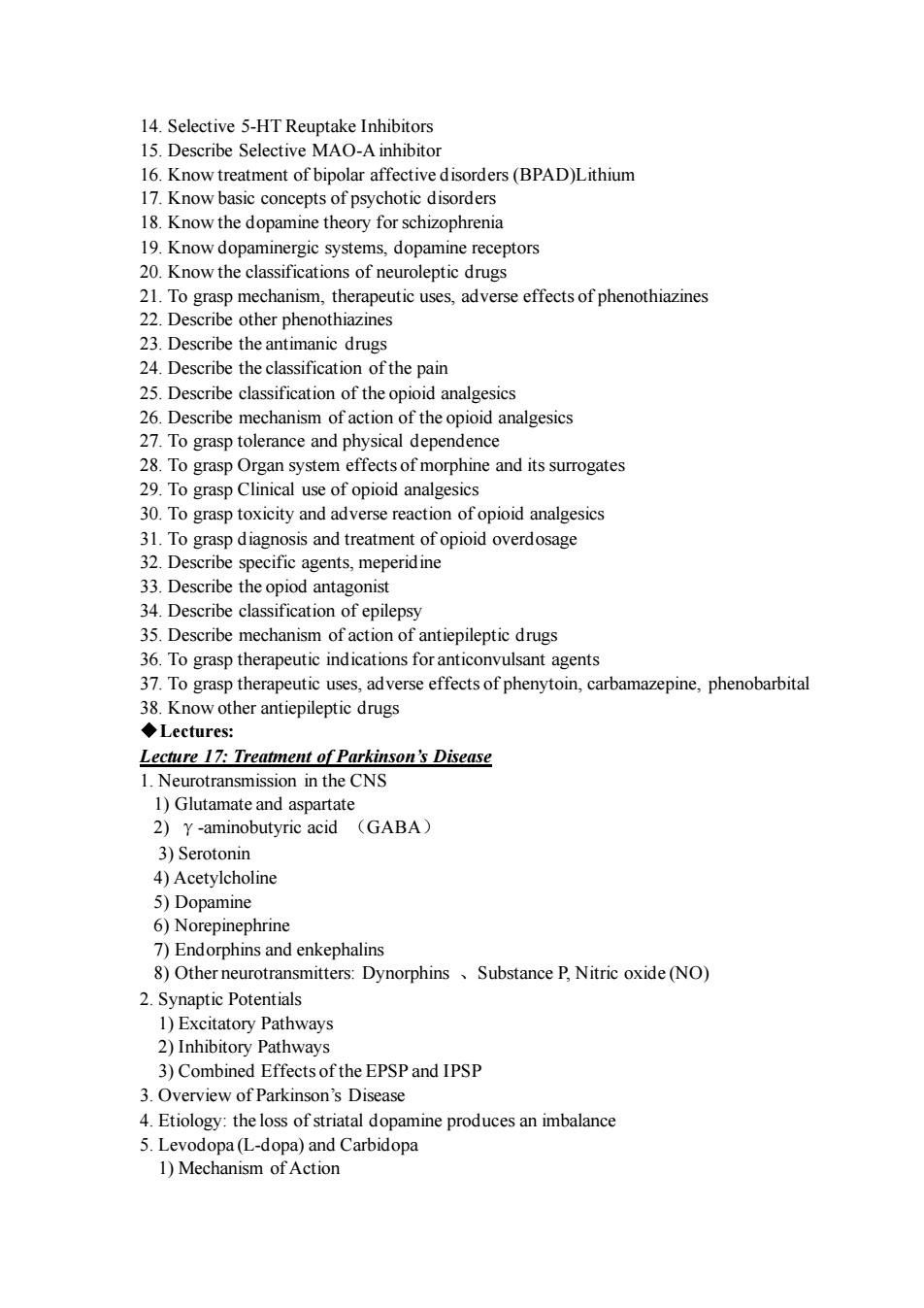
14 Selective 5-HT Reuntake inhibitor 15.Describe Selective MAO-Ainhibito 16.Know treatment of bipolar affective disorders(BPAD)Lithium 17.Know basic concepts of psychotic disorders 18.Know the dopamine theory for schizophrenia 19.Know dopaminergic systems,dopamine receptors 20.Know the assifications of 21.To grasp mechanism,therapeutic uses adverse effects ofphenothiazines 22.Describe other phenothiazines 23 Describe the antimanic drugs 24.Describe the classification of the pain 25.Describe classification of the opioid anal sics 26.Describe mechanism of action of the opioid analgesics 27.To grasp tolerance and physical dependence 28.To grasp Organ system effects of morphine and its surrogates 29.To grasp Clinical use of opioid analgesics 30.To grasp toxicity and adverse reaction of opioid analgesics osis and treatment of opioid overdosage 33.Describe the opiod antagonist 34.Describe classification of epilepsy 35.Describe mechanism of action of antiepileptic drugs 3.To grasp therapeutic indicat ons fo ticonv lsa sents 37.To grasp therapeutic uses,adverse effects of phenytoin,carbamazepine,phenobarbital 38.Know other antiepileptic drugs ◆Lectures: Lecture 17:Treatment of Parkinson's Disease 1.Neurotransmission in the CNS 1)Glutamate and (GABA) 3)Serotonin 4)Acetylcholine 5)Dopamine 6)No ephrine 7)Endorphins and enkephalins 8)Other neurotransmitters:Dynorphins Substance P.Nitric oxide(NO) 2 Synantic Potentials 1)Excitatory Pathways 2)Inhibitory Pathy 3)Combined Effectsof the EPSP and IPSP 3.Overview of Parkinson's Disease 4.Etiology:the loss of striatal dopamine produces an imbalance 5.Levodopa(L-dopa)and Carbidopa 1)Mechanism of Action
14. Selective 5-HT Reuptake Inhibitors 15. Describe Selective MAO-A inhibitor 16. Know treatment of bipolar affective disorders (BPAD)Lithium 17. Know basic concepts of psychotic disorders 18. Know the dopamine theory for schizophrenia 19. Know dopaminergic systems, dopamine receptors 20. Know the classifications of neuroleptic drugs 21. To grasp mechanism, therapeutic uses, adverse effects of phenothiazines 22. Describe other phenothiazines 23. Describe the antimanic drugs 24. Describe the classification of the pain 25. Describe classification of the opioid analgesics 26. Describe mechanism of action of the opioid analgesics 27. To grasp tolerance and physical dependence 28. To grasp Organ system effects of morphine and its surrogates 29. To grasp Clinical use of opioid analgesics 30. To grasp toxicity and adverse reaction of opioid analgesics 31. To grasp diagnosis and treatment of opioid overdosage 32. Describe specific agents, meperidine 33. Describe the opiod antagonist 34. Describe classification of epilepsy 35. Describe mechanism of action of antiepileptic drugs 36. To grasp therapeutic indications for anticonvulsant agents 37. To grasp therapeutic uses, adverse effects of phenytoin, carbamazepine, phenobarbital 38. Know other antiepileptic drugs ◆Lectures: Lecture 17: Treatment of Parkinson’s Disease 1. Neurotransmission in the CNS 1) Glutamate and aspartate 2) γ-aminobutyric acid (GABA) 3) Serotonin 4) Acetylcholine 5) Dopamine 6) Norepinephrine 7) Endorphins and enkephalins 8) Other neurotransmitters: Dynorphins 、Substance P, Nitric oxide (NO) 2. Synaptic Potentials 1) Excitatory Pathways 2) Inhibitory Pathways 3) Combined Effects of the EPSP and IPSP 3. Overview of Parkinson’s Disease 4. Etiology: the loss of striatal dopamine produces an imbalance 5. Levodopa (L-dopa) and Carbidopa 1) Mechanism of Action